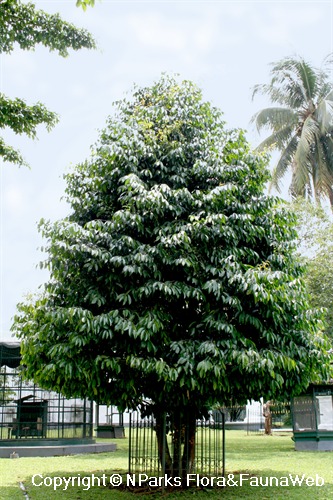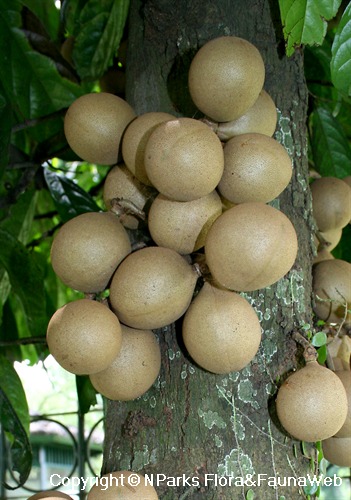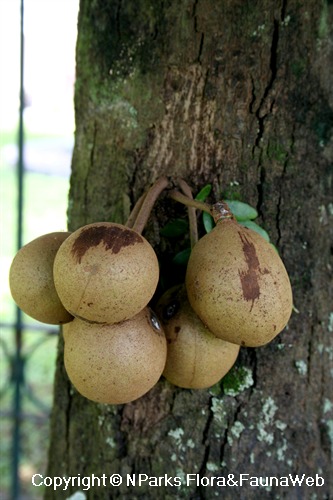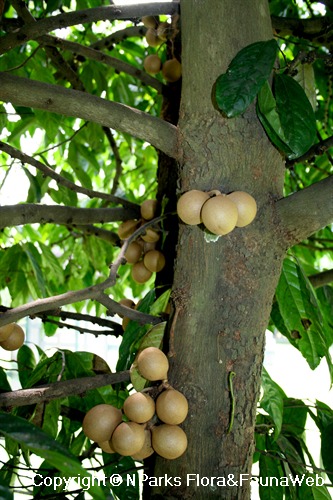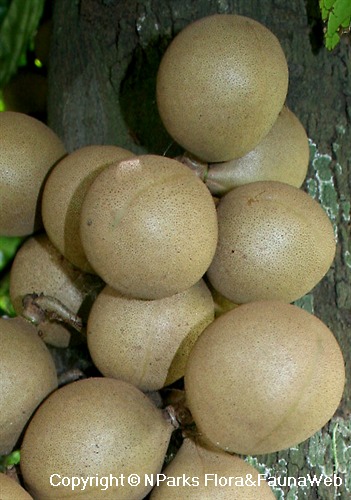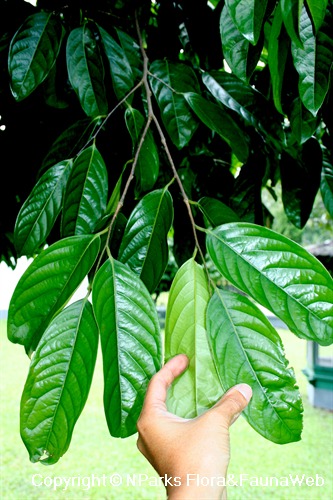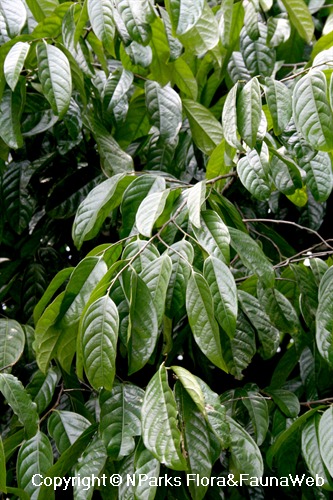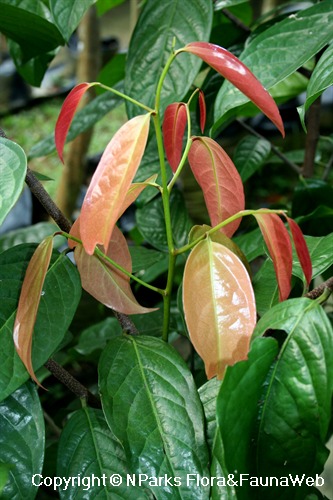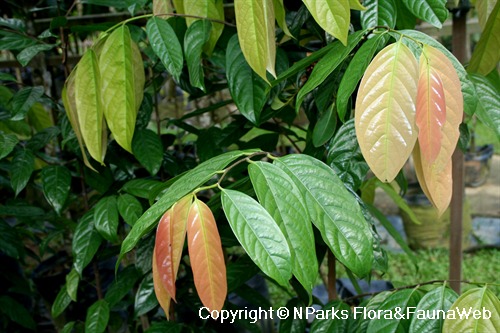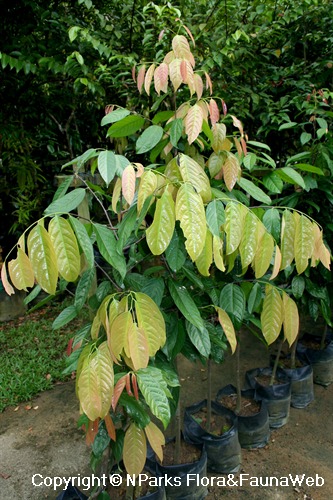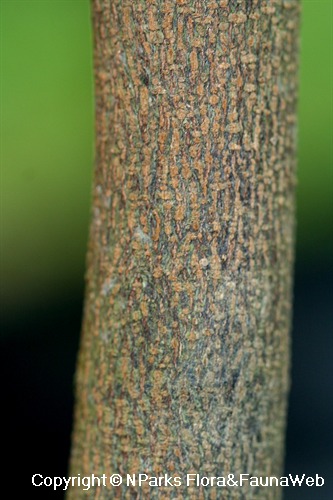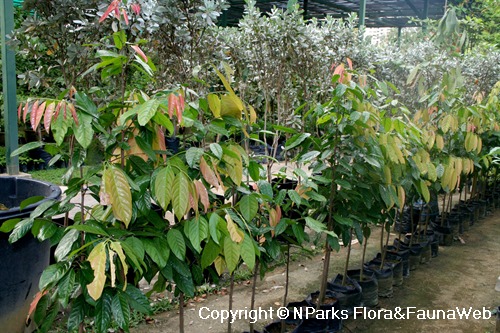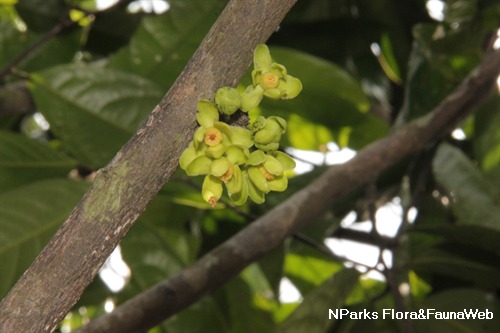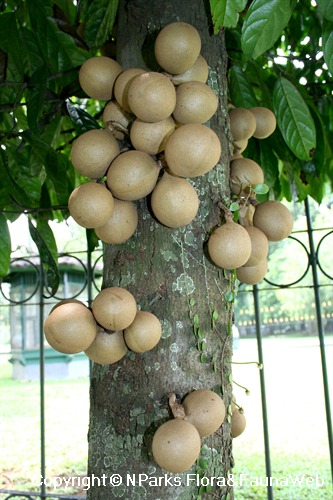
Back
Stelechocarpus burahol (Blume) Hook. f. & Thomson
| Family Name: | Annonaceae |
| Synonyms: | Uvaria burahol |
| Common Name: | Kepel, Kepel Apple, Burahol, Keppel Tree |
Name
Classifications and Characteristics
| Plant Division | Angiosperms (Flowering Seed Plants) (Dicotyledon) |
|---|---|
| Plant Growth Form | Tree (Medium (16m-30m)) |
| Lifespan (in Singapore) | Perennial |
| Mode of Nutrition | Autotrophic |
| Plant Shape | Conical |
| Maximum Height | 25 m |
| Tree or Palm – Trunk Diameter | 0 |
Biogeography
| Native Distribution | Indonesia (Java, Sumatra, Kalimantan), Malaysia (Johor, Sabah, Sarawak) |
|---|---|
| Native Habitat | Terrestrial (Secondary Rainforest) |
| Preferred Climate Zone | Tropical |
Description and Ethnobotany
| Growth Form | Medium-sized tree up to 25m tall. Crown conical, with symmetrical lateral branching. Mature bark dark brown, scaly, flaking off in places. |
|---|---|
| Foliage | Leaves leathery and prominently veined; young flush emerge deep red, maturing to pinkish, light green and then dark green. Each episode of flushing lasts some 2 months, usually occurring before blooming and after fruit drop. |
| Flowers | Produced in clusters of 8-16, emerge greenish and age to whitish. Species is monoecious (separate male and female flowers on same plant) and exhibits cauliflory. Male flowers (1cm across) produced on upper trunk and older branches. Female flowers (3cm across) found only on lower trunk, visited by bees, ants and sometimes butterflies. Flowering season in native Java is typically from September to October yearly, with occasional off-season blooming. |
| Fruit | Pollinated female flowers give rise to tennis-ball sized fruits (5-6 cm across), ripen from green to brown in 6 months (typically March to April), with slightly warty texture. Fruits are ripe, if colour is yellow or light brown (rather than green) beneath scratched skin, containing edible, orange juicy pulp with spicy mango-like flavour (described as an acquired taste). Eaten by bats and rodents in the wild, and should be protected by bagging 1-2 months before harvest. Harvested fruits can be kept for 2-3 weeks at room temperature. Mature tree yields 1,000-1,500 fruits per year, with variation caused by irregularity in rainfall. Seeds ellipsoidal, relatively large (3cm long), 4-6 per fruit. |
| Habitat | Endangered species, native to secondary forests of Malesia. |
| Cultivation | Prefers deep, moist soils. Best propagated by seeds, as cuttings and air-layerings are reported to be unsuccessful. Seeds from mature fruits are scarified and sown immediately. Germination can take many months, seedlings are very slow-growing and may exhibit no noticeable growth, especially in first 10 months. Juvenile phase lasts 6-9 years. |
| Etymology | Genus epithet 'Stelechocarpus' derived from Greek terms of 'stelecho' (trunk, branch, stem) and 'karpos' (fruit), describing the cauliflorus nature of this species, and how the fruits are bore directly on the main woody parts of the tree. Common name 'Kepel' means 'of clenched fist' in Malay, all allusion to the fist-sized fruits. |
| Ethnobotanical Uses | Edible Plant Parts : Edible Fruits, Edible Flowers Food (Fruit or Vegetable) (Herb or Spice) Others: Food: Cultivated in Indonesia for fruits, which are eaten fresh when ripe. Pulp popularly consumed by Indonesians who believe its natural deodorizing effects would lend a lavender-like fragrance to bodily secretions (urine, perspiration), breath and odour. Use of the fruits traditionally restricted to royalty and aristocracy. Flowers are also eaten for same reason. Medicinal: Fruit pulp used as diuretic, to prevent kidney inflammation, and cosmetically in "jamu awet ayu" (traditional Malay medicinal herbs for "lasting beauty"). Also causes temporary sterility in women, and used by royal ladies and consorts as contraceptive. Products: Timber used to make household articles. Trunk is used in house-building, and reported to last more than 50 years. |
Landscaping Features
| Desirable Plant Features | Fragrant (Flowers) (Time Independent), Ornamental Fruits |
|---|---|
| Landscape Uses | General |
| Thematic Landscaping | Economic Garden, Naturalistic Garden |
Fauna, Pollination and Dispersal
| Fauna Pollination Dispersal Associated Fauna | Butterfly-Attracting |
|---|---|
| Pollination Method(s) | Biotic (Fauna) (Insects (Bee), Insects (Butterfly, Moth), Insects (Ant, Beetle, Fly, Thrip, Wasp)) |
Plant Care and Propagation
| Light Preference | Full Sun |
|---|---|
| Water Preference | Moderate Water |
| Plant Growth Rate | Slow |
| Rootzone Tolerance | Fertile Loamy Soils, Well-Drained Soils |
| Maintenance Requirements | Moderate |
| Propagation Method | Seed |
| Propagule Establishment Remarks | Propagation attempts by cuttings and air layering reported to be unsuccessful. Seeds should be sown fresh. Extract seeds from mature fruits, wash clean and dry under shade. Scarify seeds before sowing. Germination may take many months, but high percentage of germination. Germination is hypogeal, with taproot swollen and unbranched for sometime. Seedlings very slow-growing, especially at initial stage, may not display obvious growth for first 10 months. Transplant saplings of 0.5-1.0m height to field at 8-10m apart. Juvenile phase lasts 6-9 years. |
| Planting Distance | 6 m to 9 m |
Foliar
| Foliage Retention | Evergreen |
|---|---|
| Mature Foliage Colour(s) | Green |
| Mature Foliage Texture(s) | Smooth, Glossy / Shiny, Leathery, Raised / Sunken Veins, Thick |
| Prominent Young Flush Colour(s) | Red |
| Foliar Type | Simple / Unifoliate |
| Foliar Arrangement Along Stem | Alternate |
| Foliar Shape(s) | Non-Palm Foliage (Oblong) |
| Foliar Venation | Pinnate / Net |
| Foliar Margin | Entire |
| Foliar Apex - Tip | Acuminate |
| Foliar Base | Cuneate |
| Typical Foliar Area | Mesophyll ( 45cm2 - 182.25 cm2 ) |
| Leaf Area Index (LAI) for Green Plot Ratio | 4.0 (Tree - Dense Canopy) |
Non - Foliar and Storage
| Trunk Type (Non Palm) | Woody |
|---|---|
| Bark Colour(s) | Brown |
| Mature Bark Texture | Peeling / Flaking / Papery, Scaly |
| Stem Type & Modification | Woody |
| Root Type | Underground (Tap Root, Fibrous Root) |
Floral (Angiosperm)
| Flower & Plant Sexuality | Unisexual Flowers , Monoecious |
| Flower Colour(s) | Cream / Off-White, White |
|---|
| Flower Size - Remarks | 1cm across, 8-16 flowers per inflorescence |
| Flowering Habit | Polycarpic |
| Inflorescence Size Remarks | Flowers emerge greenish and mature to whitish. |
| Flowering Period Remarks | Typical blooming period in Java is September and October. |
Fruit, Seed and Spore
| Mature Fruit Colour(s) | Brown |
|---|---|
| Fruit Classification | Simple Fruit |
| Fruit Type | Fleshy Fruit , Berry |
Image Repository
Others
| Master ID | 17912 |
|---|---|
| Species ID | 3344 |
| Flora Disclaimer | The information in this website has been compiled from reliable sources, such as reference works on medicinal plants. It is not a substitute for medical advice or treatment and NParks does not purport to provide any medical advice. Readers should always consult his/her physician before using or consuming a plant for medicinal purposes. |

